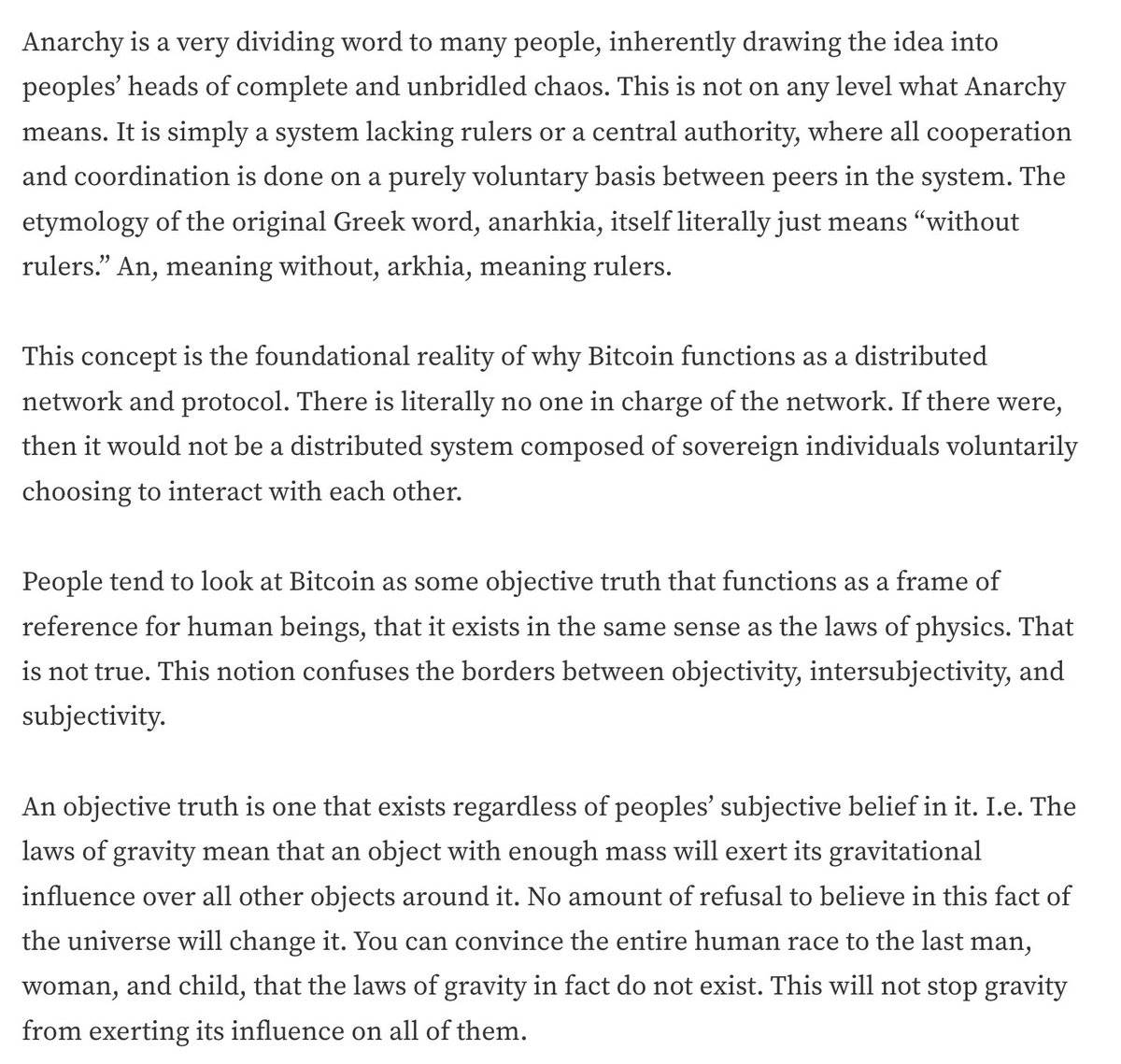Author: hitesh.eth
Compiled by: TechFlow
I won’t confirm or challenge your views through charts, historical structural comparisons, or popular theories—so if you’re just looking for confirmation or expecting to see information that matches your expectations, you may be disappointed. Because what I’m going to say next requires you to pay attention to every detail I share.
Two Paths Forward
The crypto market is currently at a critical crossroads, facing two different paths forward - each with its own unique advantages and disadvantages.
The first path leads to more freedom and adventure, while the second path means greater control and constraints.
The Essence of Crypto: The Quest for Anarchy
Cryptography is not a new concept - the idea has been in the works for 50 or 60 years. Thousands of cryptographers have laid the foundation for today's technology. Their goal is to build a true "crypto-anarchy".

This is a world without legal identity, a society where everyone can be anonymous, an ecosystem completely free from government control, where governance, currency, communication, interaction and collaboration are all decentralized through encryption technology.
In such a world, people are free to create open markets, make unconditional transactions, avoid taxes, and control their own wealth and lives.
Yet our lives have long been controlled by corrupt governments and banks that have created a false sense of security so that we never realize we have been trapped in this economic trap for hundreds of years.
Bitcoin: A wake-up call
We need an awakening, and Bitcoin is the voice of that awakening.
Bitcoin points the way to building crypto-anarchy. It offers a radically new alternative to the traditional financial system, giving individuals full control over their wealth without having to rely on banks or governments. Bitcoin is the first to achieve a truly decentralized, censorship-resistant, and transparent monetary system. “The word anarchy is controversial to many, often conjuring up images of total chaos out of control. However, in reality, that’s not what it really means. Anarchy simply refers to a system without rulers or central authority, where all cooperation and coordination is based entirely on voluntary actions between individuals within the system. From the etymology, the Greek word anarhkia literally means without rulers, where an means without and arkhia means ruler.
This concept is the core foundation of Bitcoin's ability to function as a distributed network and protocol. In the Bitcoin network, no one person has absolute control. If there is a centralized controller, then Bitcoin is no longer a distributed system of autonomous individuals who interact with each other on a voluntary basis.
Some people tend to view Bitcoin as an objective truth similar to the laws of physics, which can be used as a reference frame for human behavior. However, this view is incorrect. It actually confuses the differences between objectivity, intersubjectivity, and subjectivity.
An objective truth is a fact that exists whether or not people believe in it. For example, the law of gravity states that an object with sufficient mass will exert a gravitational influence on other objects around it. Even if all of humanity—every man, woman, and child—were persuaded that gravity did not exist, that would not change the fact that it would continue to act on them.”

Image source: BitcoinMagazine
In 2008, Satoshi Nakamoto published the Bitcoin white paper. This was not only a technological revolution, but also a change in thought. It questioned centralized monetary control and revealed the inherent flaws of the legal currency system controlled by governments and financial elites. This marked the first step for human civilization to break free from long-term economic oppression.
The emergence of Ethereum further promoted the development of blockchain technology. It built a complete development infrastructure, enabling developers to explore various application scenarios of blockchain, thus setting off the first wave of crypto anarchy.
Tokenize Everything
To achieve crypto anarchy, we need a strong infrastructure that allows people to tokenize all kinds of things - whether it is a concept described in words or content presented in images, they can give them new value through tokenization and build liquid markets around them.
"Computer technology is entering an era in which individuals and groups will be able to communicate and interact with each other in a completely anonymous manner. Two people can exchange information, conduct business, and enter into electronic contracts without knowing each other's real name or legal identity. Interactions on the Internet will become untraceable through widely rerouted encrypted packets and almost completely tamper-proof encryption protocols. In such an environment, reputation will become the most important asset, even more important than today's credit rating. These technological developments will completely change the way governments regulate, affect taxation and economic control, and subvert traditional ways of keeping information confidential, and even reshape the definition of trust and reputation.
The theoretical foundations for this coming revolution—which will undoubtedly be both social and economic—were laid a decade ago. Its core technologies include public key cryptography, zero-knowledge interactive proof systems, and a variety of software protocols for interaction, authentication, and verification. In the past, this research was concentrated in academic conferences in Europe and the United States and was closely monitored by the National Security Agency. However, only recently have computer networks and personal computers become fast enough to make these theories a reality. Further technological developments in the next decade will make these ideas economically feasible and almost impossible to stop. Technologies such as high-speed networks, ISDN, tamper-resistant devices, smart cards, satellites, Ku-band transmitters, multi-core high-performance personal computers, and cryptographic chips that are being developed will be key to promoting this change.
Of course, states will try to prevent the spread of this technology through various means, citing national security, the potential for the technology to be exploited by drug dealers and tax evaders, and concerns about the breakdown of social order. These concerns are somewhat justified: crypto-anarchism could allow state secrets to be traded freely, and could also spawn markets for illegal and stolen goods. Even anonymous computerized markets could allow for disturbing transactions such as assassinations and extortion. And various criminal organizations and foreign powers could become major users of "CryptoNet". However, these obstacles will not stop the spread of crypto-anarchism.
Just as the invention of printing undermined the dominance of medieval guilds and social power structures, cryptography will fundamentally change the way corporations and governments intervene in economic transactions. Combined with the emerging information market, crypto-anarchism will create a free market for anything that can be expressed in words and pictures. Just as seemingly simple inventions—such as barbed wire—allowed vast pastures and farmlands to be fenced, thus revolutionizing the concept of land and property rights on the Western frontier, discoveries from an obscure branch of mathematics will become the tools to cut through the "barbed wire" of intellectual property.
You have nothing to lose but the barbed wire fence that holds you captive!"

Source: Crypto-Anarchy Manifesto
In 1988, legendary cypherpunk Timothy C. May described a future world full of freedom and privacy in his Crypto-Anarchist Manifesto. He envisioned a society beyond government control and centralized control, empowering humans with privacy, autonomy, and freedom through cryptography. In his vision, encrypted communications, anonymous transactions, and decentralized systems would render traditional oppressive institutions useless. His manifesto was not only a technical blueprint, but also an ideological enlightenment, laying the ideological foundation for Bitcoin and the entire cryptocurrency movement. The manifesto became a call to developers and thinkers, encouraging them to view cryptography as the ultimate tool for human liberation.
Bonding Curve: The key to unlocking new markets
If you temporarily ignore the price fluctuations in the market and focus only on the development trend behind it, you will find that a key liquidity enabler was unlocked last year - the Bonding Curve.
Bonding Curve is a mathematical model that can create thousands of different liquidity markets around anything that can be described in words. For image assets, we have witnessed the explosion of NFTs (non-fungible tokens) in the last round of crypto market cycles. Today, this emerging experiment is gradually leading us to build more liquidity markets to meet the needs of different fields.
Memes as Marketplace
On the surface, it may seem absurd to create a liquid market for things that may be meaningless, but in fact, the core idea of this behavior is Memes. We are creating markets because we believe that there will always be people willing to speculate around a Meme or concept. So we provide them with an opportunity to participate in it through on-chain transactions and profit from it.
When people speculate, they tend to have beliefs about what they are investing in based on certain theories or data. So, in essence, we are building liquid markets for various tokenized beliefs. These markets not only meet the needs of speculators, but also promote the diversification of the entire crypto ecosystem.
The Wild West of Crypto Anarchy
In crypto-anarchy, people can trade all kinds of things, including opinions, trends, stories, articles, songs, memes, research papers, reputation, gossip, reviews, recipes, and even many things we haven’t even imagined yet... This is an extremely free and open state.
All of this was foreseen in Timothy C. May’s Crypto-Anarchy Manifesto. We were supposed to get there one day, and now, with advances in technology and infrastructure, we are able to support all kinds of new and exotic liquidity markets. However, the main problem is that most of these markets are being manipulated by a few powerful players who are trying to extract more benefits through centralization.
An important solution to achieve fair incentive distribution in these liquidity markets is to build a reputation layer. This system allows market participants to verify the reputation of creators before trading, and creators can also verify the reputation of users before accepting users into the market. https://x.com/eli5_defi/status/1830538370046673067
We now have technologies like ZkTLS (a zero-knowledge transport layer security protocol) and infrastructure like @nillionnetwork. These tools give us the possibility to build reputation systems to achieve fairer incentive distribution at the application level. As these technologies mature, we will eventually solve the reputation problem in crypto-anarchy.
The future: two clear paths
The future of the crypto world will present two completely different development paths, and you can switch between them according to your needs and preferences.
The first path is to participate in an evolving crypto-anarchy where new markets emerge, attention shifts quickly, and fortunes rise and fall in speculative cycles. Those who can adapt to change quickly and take action will have an advantage in this environment.
The second path leads to a regulated and controlled crypto economy, where stability, compliance, and structured investment opportunities are at the core. This path is more suitable for traditional financial institutions and large institutional investors, who prefer to operate in a more predictable but also more restricted environment.
We are at a critical watershed in crypto history. When crypto regulation is formally introduced in the United States, the line between these two paths will become clearer.
The regulated market will focus on Web3 businesses that can generate real revenue and projects with sufficient cash flow, which will also be the starting point of the first bull market cycle under authoritative supervision.
At the same time, in the crypto anarchy, changes in fringe markets will continue to advance at an alarming pace. If you face 100 markets, 99 of them may experience declines, while the remaining one may absorb the liquidity of other markets and rise quickly. In this environment, attention will become particularly valuable, and those who can keenly perceive trends and flexibly respond to changes will still have an advantage in this competition.
Somewhere in the crypto anarchy, there is always a bull market brewing quietly. Whether you can discover it and seize the opportunity depends on your vision and action.
Take heart! You have nothing to lose except the obstacles that hold you back.











